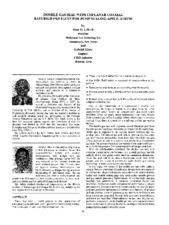| dc.description.abstract | There has been a rapid growth in the application of noncontacting double seals with a gas buffer fluid to pump sealing. The advantages of such a sealing arrangement are:
• There is no liquid buffer fluid to maintain or dispose of.
• Gas buffer fluid causes a minimum of contamination to the process.
• There are no emissions, so no monitoring may be required.
• Friction power is only a fraction of that associated with liquid seals.
• Because there is no contact, seal life can be several times that of a liquid/contacting seal.
One of the limitations of a conventional double seal arrangement, be it gas or liquid, is that there must be either considerable axial length or considerable diametral space available. There are many pump applications that could benefit from a double gas buffered sealing system where space is severely limited. Thus, there is a need for a small size double gas sealing device. The double gas seal with coplanar coaxial Rayleigh pad faces has two gas sealing faces concentrically located on the same plane. Buffer gas is supplied to an annular groove between the two sealing faces. The outside gas seal leaks to process and the inside gas seal leaks to atmosphere. Both faces have Rayleigh step pad lifting surfaces as well as a sealing dam similar to a conventional gas seal. The process fluid is to the outside of the outer seal face so as to minimize process fluid contamination of the gas seal face. With the configuration described, the double gas seal with coplanar coaxial faces can be made into a small package that fits entirely into a seal gland, which itself has minimum dimensions. Thus this seal will fit to most conventional small bore ANSI pumps, and this makes it possible to apply double gas sealing technology to many existing process pumps. In this paper, the theory of the double gas seal with coplanar coaxial faces is described. Considerable design work was required to find useable shapes and balance moments on the seal so that the inside and outside sealing gaps stay open under variable process and gas supply pressures. Optimization of the Rayleigh step pad bearings was performed. A complete simulation model was developed. Deflection results and predicted performance (leakage) are presented. Extensive testing has been conducted, and the paper presents predicted and measured leakage as a function of process and gas pressure. Loss-of-gas testing has also been performed, and these results are presented. Several field tests have been initiated and these are described. Observation so far has been that the seal performs as expected, so the double gas seal with coplanar coaxial faces can be used to provide double gas sealing solutions for many pumps having limited available space. | en |


